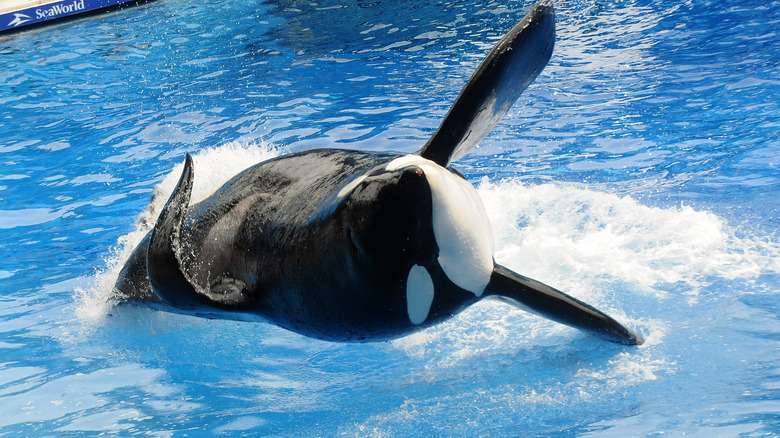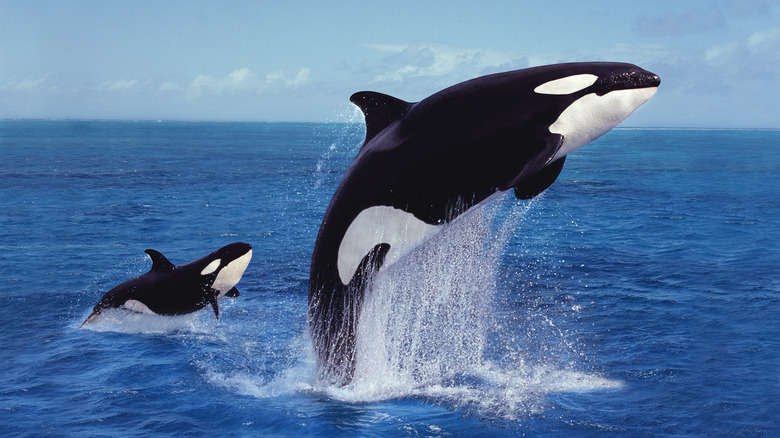The Tragic Death Of SeaWorld Trainer Dawn Brancheau
The conclusion of the autopsy report is discomfiting in its clinical summation: "In consideration of the circumstances surrounding the death and after examination of the body [...] it is my opinion that the death of Dawn Brancheau, a 40-year-old white female, is the result of drowning and traumatic injuries. The manner of death is accident."
The formality of the writing is a reprieve from the reality of the event — a vicious and brutal attack by an orca named Tilikum, that had been captured at the age of 2 off Iceland's coast and had since been held as part of SeaWorld's captive breeding program, per National Geographic. His life there was one of extreme contrasts. By nature, he was an apex predator but by circumstance, he was confined and, perhaps unnaturally, trained to perform in the park's famous animal entertainment performances.
Brancheau's death was undoubtedly shocking but was it unexpected? Hardly. Tilikum had killed before.
Brancheau's journey to SeaWorld
Dawn Brancheau's story ended where it began. According to Dawn's Foundation, a non-profit that Brancheau's family founded in the wake of her death that aims to improve the lives of both children and animals in need, Brancheau saw the famous Shamu show as a young girl and was determined to become a whale trainer.
It might have been an unusual dream for a girl from landlocked Indiana but, from all accounts, Brancheau was a singular person. According to PeoplePill, Brancheau earned degrees in both psychology and animal behavior from the University of South Carolina and began her career working with dolphins at a Six Flags in New Jersey but landed her dream job at SeaWorld in 1994. It was there she met her husband, who worked as a stunt waterskier at the park, and the two married in 1996.
Beautiful and a natural entertainer, Brancheau soon became the face of many SeaWorld ads and billboards and her face was familiar to countless people in Orlando. Soon, her performances with her beloved killer whales became a star attraction. She and Tilikum were performing "Dine with Shamu," a show for guests sitting poolside at the complex's restaurant that February day in 2010. They'd done it countless times before and nothing should have been different about this performance.
Tilikum's journey to SeaWorld
Unlike Brancheau, Tilikum's path to that fateful show had been entirely out of his control. Many who've seen the 2013 film "Blackfish" may remember the outline of Tilikum's story — taken from his mother, arguably too young, living in confinement in spaces far too small for him, and being bullied by other orcas to the point that his behavior became erratic and downright frightening.
"Blackfish" co-writer Tim Zimmerman was quoted by National Geographic as describing Tilikum's circumstances as a reality that "involved separation from family, confinement, boredom, chronic disease, aggression among marine park killer whales, and aggression against trainers." In other words, the signs of trouble were there long before the incident with Brancheau.
In 1991, another SeaWorld trainer, Keltie Lee Byrne, had fallen into a tank and was found to have died largely because several of the orcas — Tilikum among them — prevented her from getting to safety, per ABC News.
And in a bizarre 1999 incident, a tourist somehow got past park security after the park's closing time and either fell or was pulled into Tilikum's tank. The 27-year-old man was found naked and draped across the orca's back, having died from hypothermia.
Brancheau's death and its aftermath
Despite these concerns, the orca programs went on. On the day of her death, Brancheau has been laying on a pool deck, face to face with Tilikum during a performance photo op for the crowd, according to the New York Post, when witnesses say the orca came up out of the water and in a matter of seconds, grabbed the trainer either by the shoulder or hair (accounts vary), pulling her in.
For nearly 30 minutes, rescuers tried to get to her but with an agitated 22-feet-long, 12,000 pound orca to contend with, they were unable to reach her. For much of that time, Brancheau was caught in the grip of Tilikum's powerful mouth. He released her only momentarily before grabbing her again. Crowds watched, horrified, and were dispersed by staff. Mercifully, one witness was quoted as saying that Brancheau "did not look conscious any time I could see her." Despite efforts by rescuers, she could not be saved.
With Brancheau's death came big changes for the park. According to CNN, in March of 2016, following an intense public backlash over both Brancheau's death and the larger debate around the morality of keeping marine animals captive, SeaWorld announced its captive breeding program was coming to an end. Those animals currently in its care would be the last.
In January of 2017, Tilikum died at SeaWorld, after having lived in captivity for more than three decades.



